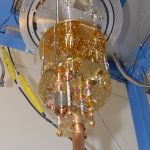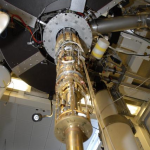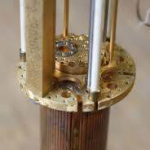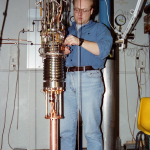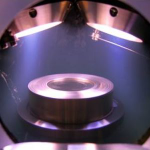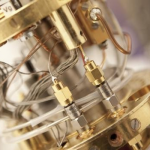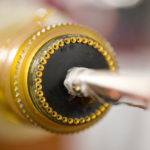

- Photon Transport in a Bose-Hubbard Chain of Superconducting Artificial Atoms
G. P. Fedorov et al., Phys. Rev. Lett. 126, 180503 (2021) - Path-Dependent Supercooling of the
He3 Superfluid A-B Transition
Dmytro Lotnyk et al., Phys. Rev. Lett. 126, 215301 (2021) - Superconductivity in an extreme strange metal
D. H. Nguyen et al., Nat Commun 12, 4341 (2021) - High-Q Silicon Nitride Drum Resonators Strongly Coupled to Gates
Xin Zhou et al., Nano Lett. 21, 5738-5744 (2021) - Measurement of the 229Th isomer energy with a magnetic micro-calorimeter
T. Sikorsky et al., Phys. Rev. Lett. 125 (2020) 142503
Production, isolation and characterization of radiochemically pure 163Ho samples for the ECHo-project
Holger Dorrer, Katerina Chrysalidis, Thomas Day Goodacre, Christoph E. Düllmann, Klaus Eberhardt, Christian Enss, Loredana Gastaldo, Raphael Haas, Jonathan Harding, Clemens Hassel, et al.Several experiments on the study of the electron neutrino mass are based on high-statistics measurements of the energy spectrum following electron capture of the radionuclide 163Ho. They rely on the availability of large, radiochemically pure samples of 163Ho. Here, we describe the production, separation, characterization, and sample production within the Electron Capture in Holmium-163 (ECHo) project. 163Ho has been produced by thermal neu- tron activation of enriched, prepurified 162Er targets in the high flux reactor of the Institut Laue-Langevin, Gre- noble, France, in irradiations lasting up to 54 days. Irra- diated targets were chemically processed by means of extraction chromatography, which allowed separating the formed Ho from the 162Er target-material and from the main byproducts 170Tm and 171Tm, which are co-produced in GBq amounts. Decontamination factors of >500 for Er and of >105 for Tm and yields of 3.6 · 1016and 1.2 · 1018 atoms of 163Ho were obtained, corresponding to a recovery yield of 95 % of Ho in the chemical separation. The Ho-fraction was characterized by means of γ-ray spectrometry, Induc- tively-Coupled-Plasma Mass Spectrometry (ICP-MS), Reso- nance Ionization Mass Spectrometry (RIMS) and Neutron Activation Analysis (NAA). In this process, the thermal neutron capture cross section of 163Ho was measured to σHo-163 to Ho-164m = (23 ± 3) b and σHo-163 to Ho-164g = (156 ± 9) b for the formation of the two isomers of 164Ho. Specific samples were produced for further purification by mass separation to isolate 163Ho from the Ho-isotope mixture, as needed for obtaining the energy spectrum within ECHo. The partial efficiency for this second separation step is (32 ± 5) %.
Radiochim. Acta (2018) 106(7), 535-547
doi: 10.1515/ract-2017-2877

